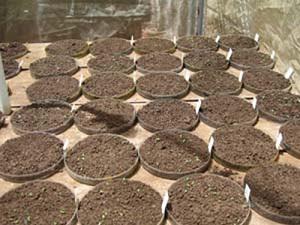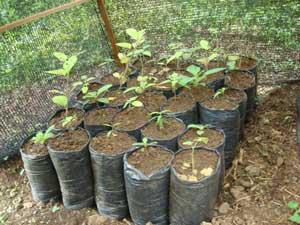Jorge Luis Renteria
Other projects
11 Nov 2010
Impacts of the Invasive Blackberry (Rubus niveus) on the Native Vegetation of the Scalesia Forest in Santa Cruz, Galapagos
This project aims to establish alternative control strategies to improve the management of Rubus niveus and Leucaena leucocephala, two of the most invasive plant species in the Galapagos Islands.

Seed herbicides trails for the control of the seedbank of Rubus niveus, 5 different herbicides. © Jorge Renteria.
Approximately 800 plant species have been introduced to the Galapagos. Although many introduced plant species have not significantly affected the ecological equilibrium of the islands, a smaller number of introduced plant species are invading the National Park and private farmland, causing environmental damage and economic problems. The worst effects are caused by the trees Psidium guajava, Cedrela odorata, Leucaena leucocephala and Cinchona pubescens, and the bushes such as Lantana camara and Rubus niveus.

Seedlings of blackberry and native plant species under one of treatments of light and water. © Jorge Renteria.
Many vines and grasses are also causing serious problems. During the last two decades, the Galapagos National Park Service and the Charles Darwin Foundation have been carrying out control and eradication programs to restore natural areas degraded by invasive plant species. Limited financial resources and the ability of the weeds to persist for long periods through the soil seed bank have been the main constraints for the successful restoration of plant communities. Herbicides will continue to play a key role on the management of invasive plants species. However, it is necessary to develop new alternative control methods in order to reduce weed seeds in the soil, reduce weed emergence from the seed bank, and minimize competition with native species.
Leucaena leucocephala and Rubus niveus are two invasive plant species in the Galapagos. These invasive mature young and have long-lived seed banks (estimated at least 10 years). These aspects directly influence the cost and effectiveness of short-term control projects. Chemical and physical control methods will be tested in order to reduce the viable seed bank available in the soil. Revegetation techniques using native and non-invasive introduced species will be used to out-compete the invasive species and encourage the establishment of a desirable plant community. The new methodologies that will be studied will help to revolutionize weed control in Galapagos. They will reduce the cost and duration of control projects. They will also reduce chemical application levels to the soil and reduce the likelihood of reinvasion by weeds.
This is a three-year project. During the first field work season suitable experimental sites will be selected; seeds and seedling of species will be collected and grown in the green house. Preliminary trails will be carried out to test and refine the methodology. The product of the research will be a pragmatic and hopefully useful management plan for these invasive plants in Galapagos.